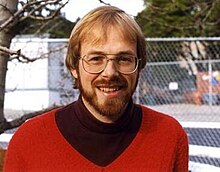Richard Taylor (mathematician)
Richard Lawrence Taylor (born 19 May 1962) is a British mathematician. He works in number theory. He was a former research student of Andrew Wiles. He returned to Princeton to help Wiles complete the proof of Fermat's last theorem.
Richard Taylor | |
|---|---|
 | |
| Born | 19 May 1962 |
| Nationality | British |
| Alma mater | Princeton University Clare College, Cambridge |
| Awards | Whitehead Prize (1990) Fermat Prize (2001) Ostrowski Prize (2001) Cole Prize (2002) Shaw Prize (2007) |
| Scientific career | |
| Fields | Mathematics |
| Institutions | Harvard University |
| Doctoral advisor | Andrew Wiles |
| Doctoral students | Kevin Buzzard Ana Caraiani Ashley Jarvis David Savitt |
Taylor received the 2007 Shaw Prize in Mathematical Sciences. This for his work on the Langlands program. He did this work with Robert Langlands.
Career
changeTaylor received his B.A. from Clare College, Cambridge.[1][2] He received his Ph.D. from Princeton University in 1988. From 1995 to 1996 he held the Savilian Chair of Geometry[1] at Oxford University. He was also a Fellow of New College, Oxford.[2] Currently, he is the Herchel Smith Professor of Mathematics at Harvard University.
He received the Whitehead Prize in 1990, the Fermat Prize and the Ostrowski Prize in 2001. He also got the Cole Prize of the American Mathematical Society in 2002, and the Shaw Prize for Mathematics in 2007. He was also elected a Fellow of the Royal Society in 1995.
Work
changeThere are two papers which have the complete proof of Fermat's Last Theorem. One of them was written by Taylor with Andrew Wiles.[3]
In his later work, Taylor (along with Michael Harris) proved the local Langlands conjectures.[4] A simpler proof was suggested almost at the same time by Guy Henniart.[5]
Later, together with Christophe Breuil, Brian Conrad, and Fred Diamond, he completed proving the Taniyama–Shimura conjecture, by performing very difficult computations.[6]
Recently, Taylor, following the ideas of Michael Harris, developed on his work with Laurent Clozel, Michael Harris, and Nick Shepherd-Barron. He has announced that he proved the Sato–Tate conjecture, for elliptic curves with non-integral j-invariant. This partial proof of the Sato–Tate conjecture uses a theorem of Wiles.[7]
Personal life
changeTaylor is married to Christine Taylor . She is a mathematical biologist. They have two children: Jeremy and Chloe. He is also the son of British physicist, John C. Taylor.
References
change- ↑ 1.0 1.1 SAVILIAN PROFESSORSHIP OF GEOMETRY in NOTICES, University Gazette 23.3.95 No. 4359 [1] Archived 2007-10-10 at the Wayback Machine
- ↑ 2.0 2.1 ‘TAYLOR, Prof. Richard Lawrence’, Who's Who 2008, A & C Black, 2008; online edn, Oxford University Press, Dec 2007 accessed 27 March 2008
- ↑ ———; Wiles, A. (1995). "Ring theoretic properties of certain Hecke algebras". Ann. of Math. 141 (3): 553–572. doi:10.2307/2118560. JSTOR 2118560.
- ↑ Harris, M.; Taylor, R. (2001). The geometry and cohomology of some simple Shimura varieties. Annals of Mathematics Studies. Vol. 151. Princeton University Press. ISBN 0-691-09090-4.
- ↑ Carayol 1999, pp. 193–194
- ↑ Breuil, C.; Conrad, B.; Diamond, F.; Taylor, R. (2001). "On the modularity of elliptic curves over Q: wild 3-adic exercises". J. Amer. Math. Soc. 14 (4): 843–939. doi:10.1090/S0894-0347-01-00370-8. S2CID 248411511.
- ↑ ——— (2008). "Automorphy for some l-adic lifts of automorphic mod l representations. II". Publications Mathématiques de l'IHÉS. 108 (1): 183–239. doi:10.1007/s10240-008-0015-2. S2CID 8562928.